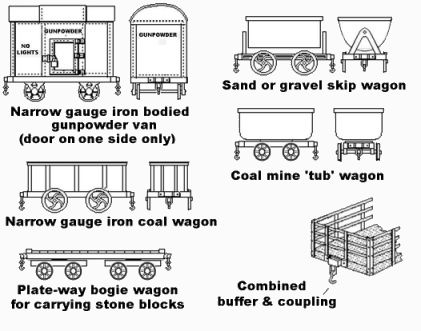Most light railways used standard gauge track, allowing wagons owned by the larger railway companies to deliver and collect along the line. A lot of the horse drawn tramways and plateways were built simply to carry coal or stone to a nearby port or to a railway proper and for these non-standard gauges were frequently used. Benjamin Outram, one of the pioneers of the plateways, used a gauge of four foot two inches (1.27m) for most of his lines and this became a common gauge in the North of England. There were many short industrial lines built in the West Midlands and these favoured gauges in the range one foot six to two foot six (0.45-0.76m). In South Wales most lines used a three foot gauge (0.9m) whilst on the quarry lines in the mountains of North Wales two foot (0.6m) gauge was common.
In the 1860s the slate lines in North Wales introduced steam power on their lines, prior to this the two foot gauge lines had been worked using gravity to take the train down from the mountain to the docks, a horse was carried in a 'dandy cart' and hauled the rake of wagons back up the line. The application of steam power to narrow gauge proved a success, the idea ws taken up in mountainous areas all over the world. One of the leading engineers on the narrow gauge lines was a man called Fairlie, who developed a double-ended engine running on what we would today call 'bogies', each one being a self contained steam engine chassis. Fairlie took his ideas to the USA where several hundred miles of narrow gauge tracks were laid around Denver in the Rocky Mountains forming the Denver and Rio Grade Railroad. Narrow gauge lines spread around the world, New Zealand, South Africa and India all developed extensive narrow gauge networks.
Narrow gauges of below three foot were well suited to mountainous areas where curves might be tight and they were also regularly used for small industrial lines operated by water works, gas works, paper mills and the like. People tend to think of narrow gauge lines as being rather antiquated, in fact a lot of steam operated commercial (i.e. not 'preserved') narrow gauge lines lasted into the later 1960's, one or two outlasted steam on the main lines.
Working in N we have the option of using Z gauge track to produce a narrow gauge line, this combination is usually called N-6.5. Z gauge is 6.5mm, which corresponds to three foot three inch gauge (0.99m) and there have been several very pleasing models built using this combination. Marklin offer track and a range of models in Z scale which can be modified to provide the motive power, Peco offer plain track and kit bodies for a narrow gauge open wagon body and a van body, both to run on Marklin chassis.
On some narrow gauge lines special transporter wagons were provided to carry other companies standard gauge wagons, the narrow gauge Leek & Manifold Light Railway provided transporter wagons of this type. I believe these transporter wagons were even used to carry six wheeled milk tank wagons, some of the heaviest goods stock on the main lines let alone a narrow gauge line.
Similarly some standard gauge companies provided transporter wagons for narrow gauge stock, the LNWR and the GWR both provided special standard gauge wagons fitted with narrow gauge rails to carry narrow gauge railway slate trucks. Both companies also provided the quarry companies with a few hundred narrow gauge wagons for slate and a few for coal.
The LNWR used four wheel transporter wagons of a fairly standard two plank drop-side design. The narrow wagons were loaded from the side across the transporter and were held in place by a wooden batten secured to the inside. Each transporter carried three of the slate trucks (four might have fitted but would have over-loaded the wagon) and they ran between the Ffestiniog wagon sidings and the nearby docks. The LNWR were grouped into the LMS in 1923 and these transporter wagons continued in use for several years until they were replaced by converted bogie 'warflat' wagons built for the First World War. The GWR used larger six wheeled chassis on which six slate wagons were loaded lengthways in two rows of three.
Fig___ Narrow gauge slate wagons and associated transporter wagons

